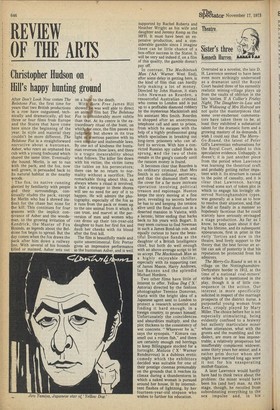Theatre,
Sister's three
Kenneth Ilurren _
Overrated as a novelist, the late D. H. Lawrence seemed to have been even more strikingly underrated as a dramatist until the Royal Court hauled three of his earnestly realistic mining-village plays up from the vaults of oblivion in the late 'sixties. If A Collier's Friday Night, The Daughter-in-Law and The Widowing of Mrs Holroyd are not quite the masterpieces that some over-exuberant commentators have taken them to be, at least they exhibited a substantial talent for the dramatic form and a growing mastery of its demands. I wish I could say that The MerryGo-Round, the latest of Peter Gill's Lawrentian exhumations for the Royal Court, added to this speculative evidence. Unhappily, it doesn't; it is just another piece from the period when Lawrence was learning the theatrical craft and probably getting rather impatient with it. Its structure is casual to the point of casualty, and it is clear that Lawrence, having evolved some sort of token plot in which to engage his lovingly observed Nottinghamshire types, was generally at a loss as to how to resolve their situation, and that he did so finally in a manner so hopelessly facetious that he could scarcely have seriously envisaged a stage production. As far as I know, he kept quiet about it during his lifetime, and its subsequent appearances, first in print in the early 'forties and now in the theatre, lend lively support to the theory that the best favour an artist can ask of posterity is that his reputation be protected from his admirers.
The Merry-Go-Round is set in a village on the NottinghamshireDerbyshire border in 1912, at the time of a national coal-miners' strike which is mentioned in the play, though it is of little consequence in the action. Our interest is more specifically solicited in respect of the marriage prospects of the district nurse, a purposeful young woman from Kent, crisply played by Mary Miller. The choice before her is not especially stimulating, being evidently confined to a brawny but sullenly inarticulate miner whose utterances, what with the grunts and the mumbling and the dialect, are more or less impenetrable; a relatively prosperous but insufferably complacent widower, some thirty years her senior; and a rather prim 'doctor whom she might have married long ago were it not for his exasperating moth--fixation.
A later Lawrence would hardly have had to think twice about the problem: the miner would have been his (and her) man. At this stage, though, he recoiled from subordinating everything to the sex impulse and, in his Preposterous ending, he ties her Up with the doctor instead. Neither option could inspire much confidence in its happy permanence (if she had to choose any of the three, she would probably have done best with the old Widower on the grounds that she would be rid of him sooner), but at least, with the doctor, she could look forward to comprehensible verbal communication.
The dialect, incidentally, is a Problem for the audience, too, and I'd advise intending patrons to get there early and bone up on a few key words which are explained in a programme-note glossary. They won't clarify everything, but if You don't know a ronk from a sawney, you're likely to come away in the mullgrubs.



































 Previous page
Previous page